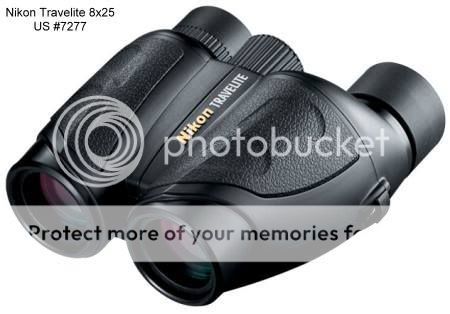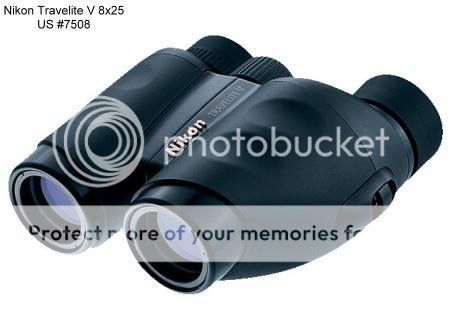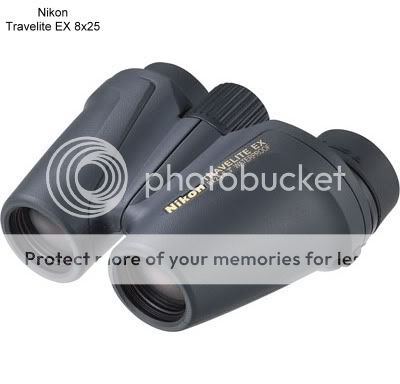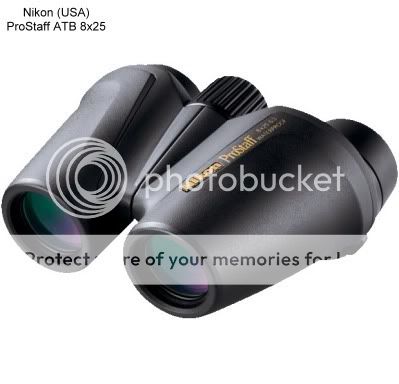I do not claim to be any expert on binoculars but I do have a long time interest and am pretty experienced at the lower end of the market.
First, any binoculars at below $100 is strictly budget and can be of pretty horrible quality - one cannot buy by specs alone - otherwise all 8x40 binoculars are going to be the same..... which is obviously not true.
All the binoculars in this ad-hoc review cost me less than $100 - yes, some sell for over $100 even at street prices like the Pentax Papilio 6.5x21 averages $130 - but I wait for opportunities that allow me to purchase those (legitimately) at below $100.
Some may laugh and say that if I had used all the monies I paid for those budget compact binoculars - I could have afforded a really nice pair of the more modern Chinese binos like the Zen-Rays.
This is true, but I've accumulated these binos over the past 20 years - and the remarkable valued Chinese binos were not available until fairly recently - overall I have no regrets and it has been fun "collecting" these - without being conscious of collecting.
Besides I really like compact binoculars - despite the fact they cannot resolve as much detail as full- or even mid-sized binoculars. But I like the way they fit my hand and usage - and also because they are very portable so they can go with me - whereas a bigger more expensive pair may stay at home.
Also because of the physical optical limitations of compact binoculars - I would be reluctant to pay more than about $200 for them - as they can't get that good anyway - hence a $100 budget.....
My story dating back to the late 80's is similar to Stephen Ingraham in his article:
on Compact Binoculars (used to be called Pocketful of Birds)
But I did buy my Nikon Venturer II 8x23 after I read the Consumer Report article on Binoculars.
Another point: I had an attempt at comparison before (5 years ago) in Post #14 of A good pair of binoculars? (over at BladeForums)
My methods - explained shortly have not changed much - but I have tried variations.
Line up:

Method:
I put up a lens testing optical test target:
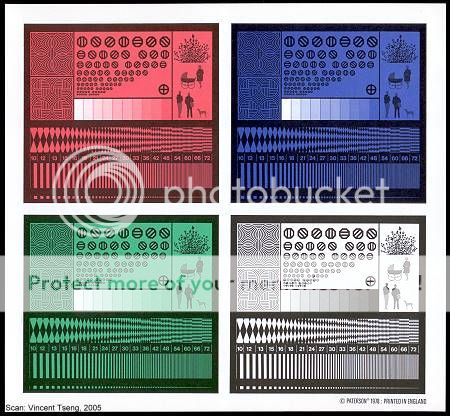
step to a distance when I could only just resolve the finest lines of the black and white panel (toward the bottom right corner) - this actually coincided with just being able to read the printing in the bottom right corner (so I used that as a double check) - ie: being able to see just slightly better than the image is displaying on the screen (due to the photo size/resolution limitation).
I did this outdoors in good light:
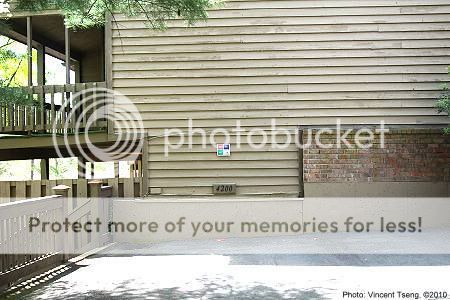
Then indoors in poorer light:
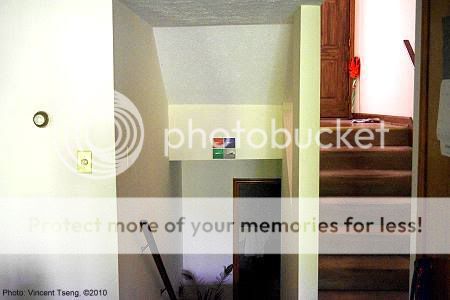
Then a more acid test somewhat against the light:

The comparison light levels were (using my exposures):
Outdoors: LV/EV = +13 or about 4,000 foot-candles = 43,000 lux
Indoors: LV/EV = +1.3 or about 1.3 foot-candles or 14 lux
Against the light: LV/EV = +3.8 or about 7 foot candles or 75 lux.
So the indoors and against the light levels were substantially lower than the outdoors scene.
I "read" the chart multiple times with each pair of binoculars confirming the distance positions I double checked being able to resolve the finest b&w lines with just being able to read the printing at the bottom of the chart.
Overall margin of error and confidence in distances to see the finest lines on the chart would be within about +/- 4 inches.
Allowing for about +/- 2 inch distance measurement error, and about +/- 2 inch reading position error.
Outdoors:
Nikon Travelite V 8x25 and Nikon Venturer II 8x 23 - tied at 35ft 5"
Nikon SportStar 8x25 - 33ft 1"
Pentax Papilio 6.5x21 - 28ft 9"
Minolta UC-II 6x16 - 27ft.
Indoors:
Nikon Travelite V and Venturer II again tied at 18ft
Nikon SportStar - 16ft 1"
Pentax Papilio - 14ft 11"
Minolta UC-II - 11ft 6"
Against the light -
Nikon Travelite V and Venturer II tied at 21ft 3"
Nikon SportStar - 19ft 2"
Pentax Papilio - 12ft 6"
Minolta UC-II - 11ft 3"
In all situations the Nikon Travelite V 8x25 and Venturer II 8x23 (now long discontinued) tied and came top.
Next were the Nikon SportStar 8x25 which really surprised me as these are cheap roof prism which is normally a no-no for quality, and I paid less than $20 new for these (if you can get these they normally average about $50).
The Pentax Papilio 6.5x21 which gandered a recommendation at ConsumerSearch.com came in next.
Pulling up the rear were the tiny Minolta UC-II 6x16 (also long discontinued) - but look at their size and the objective at only 16mm.
Now the calculations:
Using the Nikon Travelite and Venturer as 100%
we have to allow for the lower magnifications of the Pentax and Minolta
the Pentax would have to use a factor of 8/6.5 and the Minolta a factor of 8/6 to be directly comparable -ie: like they were of the same magnification.
Outdoors:
Nikon Travelite V 8x25 and Venturer II 8x23 tied 100%
Nikon SporStar 8x25 = 93.4%
Pentax Papilio 6.5x21 = 81.1% but correct for magnification = 100%
Minolta UC-II 6x16 = 76% but correct for magnification = 101%
So optically under close to ideal conditions these binoculars are about the same quality theoretically if they were of the same magnification - with perhaps the SportsStar falling just a little behind.
More adverse conditions -
indoors darker -at about LV= +1.3
Nikon Travelite V ad Venturer II tied 100%
Nikon SportStar = 89%
Pentax Papilio = 83% - with correction = 102%
Minolta UC-II = 64% - with correction = 85%
again with correction the Pentax kept up with the top Nikons - but what happened to the Minolta UC-II why did it drop from a corrected 101% outdoors to a poorly 85%?
Well it was the lower light levels the Minolta UC-II has an exit pupil of 16/6 mm = 2.67 mm - compared to the 3.12mm of the Travelite V; 2.88 of the Venturer II; and 3.23mm of the Pentax Papilio - so its image brightness is only 73% of the Travelite V, 86% of the Venturer II, and 68% of the Pentax Papilio - so in the dimmer conditions this made a difference.....
Against the light -
Nikon Travelite V and Venturer II tied = 100%
Nikon SportStar = 90%
Pentax Papilio = 59% - with correction = 72%
Minolta UC-II = 53% - with correction = 70%
Notice how both the Pentax Papilio and Minolta UC-II have dropped quite noticeably even when corrections are made?
Why?
It's flare reflections that make being able to see difficult - the Papilio has a plain sheet of glass at the front end of the binos:
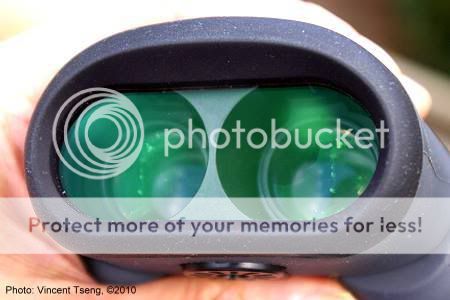
even though it is obviously multi-coated it probably causes more internal reflections which rob the binos the ability to see
Compare with the Travelite V:
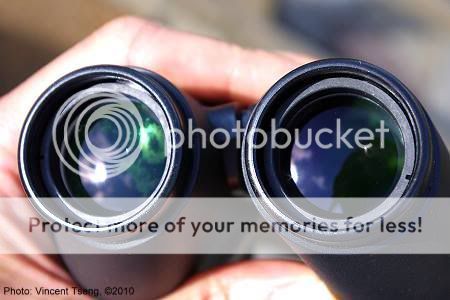
with the multi-coated objective bared.
The Minolta has an unusual design:
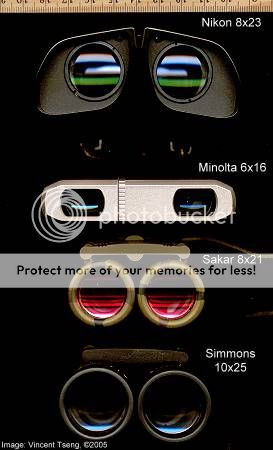
compare it to the Nikon Venturer II top (marked 8x 23)
probably because of its ultra compact nature it also has more internal reflections that rob its ability to see under more adverse conditions.
Notice also that even for the 100% Nikon Travelite V and Venturer II - that their distances were noticeably lower indoors where the lighting was lower - 60% for against the light, and 51% for lower light.
This illustrates how these compact binoculars are good for bright outdoors but are at a disadvantage when the light dims.
Prices I paid for the available binos - Travelite V 8x25 - $59, Pentax Papilio 6.5x21 - $71 and Nikon SportStar 8x25 $20.
So after all these years and other compact binoculars the Nikon Venturer II 8x23 still stands as my benchmark,
The Travelite V 8x25 does match it - but its field of view is narrower - which disturbed me initially - but I have gotten used to it - however still wish it were wider.
The Pentax Papilio is amazing not just because of its optical quality (under good conditions) but because it can focus as close as 0.5 meters or 1.6 ft that is amazing.
The Minolta UC-II 6x16 is amazing just for its size and it does perform well for what it is......
So no regrets - and its been a lot of fun for me.
For basic information and some recommendations please see
ConsumerSearch.com on Binoculars
For good basic grounding read their Full Report.
Hope this was interesting for some.
First, any binoculars at below $100 is strictly budget and can be of pretty horrible quality - one cannot buy by specs alone - otherwise all 8x40 binoculars are going to be the same..... which is obviously not true.
All the binoculars in this ad-hoc review cost me less than $100 - yes, some sell for over $100 even at street prices like the Pentax Papilio 6.5x21 averages $130 - but I wait for opportunities that allow me to purchase those (legitimately) at below $100.
Some may laugh and say that if I had used all the monies I paid for those budget compact binoculars - I could have afforded a really nice pair of the more modern Chinese binos like the Zen-Rays.
This is true, but I've accumulated these binos over the past 20 years - and the remarkable valued Chinese binos were not available until fairly recently - overall I have no regrets and it has been fun "collecting" these - without being conscious of collecting.
Besides I really like compact binoculars - despite the fact they cannot resolve as much detail as full- or even mid-sized binoculars. But I like the way they fit my hand and usage - and also because they are very portable so they can go with me - whereas a bigger more expensive pair may stay at home.
Also because of the physical optical limitations of compact binoculars - I would be reluctant to pay more than about $200 for them - as they can't get that good anyway - hence a $100 budget.....
My story dating back to the late 80's is similar to Stephen Ingraham in his article:
on Compact Binoculars (used to be called Pocketful of Birds)
But I did buy my Nikon Venturer II 8x23 after I read the Consumer Report article on Binoculars.
Another point: I had an attempt at comparison before (5 years ago) in Post #14 of A good pair of binoculars? (over at BladeForums)
My methods - explained shortly have not changed much - but I have tried variations.
Line up:

Method:
I put up a lens testing optical test target:

step to a distance when I could only just resolve the finest lines of the black and white panel (toward the bottom right corner) - this actually coincided with just being able to read the printing in the bottom right corner (so I used that as a double check) - ie: being able to see just slightly better than the image is displaying on the screen (due to the photo size/resolution limitation).
I did this outdoors in good light:

Then indoors in poorer light:

Then a more acid test somewhat against the light:

The comparison light levels were (using my exposures):
Outdoors: LV/EV = +13 or about 4,000 foot-candles = 43,000 lux
Indoors: LV/EV = +1.3 or about 1.3 foot-candles or 14 lux
Against the light: LV/EV = +3.8 or about 7 foot candles or 75 lux.
So the indoors and against the light levels were substantially lower than the outdoors scene.
I "read" the chart multiple times with each pair of binoculars confirming the distance positions I double checked being able to resolve the finest b&w lines with just being able to read the printing at the bottom of the chart.
Overall margin of error and confidence in distances to see the finest lines on the chart would be within about +/- 4 inches.
Allowing for about +/- 2 inch distance measurement error, and about +/- 2 inch reading position error.
Outdoors:
Nikon Travelite V 8x25 and Nikon Venturer II 8x 23 - tied at 35ft 5"
Nikon SportStar 8x25 - 33ft 1"
Pentax Papilio 6.5x21 - 28ft 9"
Minolta UC-II 6x16 - 27ft.
Indoors:
Nikon Travelite V and Venturer II again tied at 18ft
Nikon SportStar - 16ft 1"
Pentax Papilio - 14ft 11"
Minolta UC-II - 11ft 6"
Against the light -
Nikon Travelite V and Venturer II tied at 21ft 3"
Nikon SportStar - 19ft 2"
Pentax Papilio - 12ft 6"
Minolta UC-II - 11ft 3"
In all situations the Nikon Travelite V 8x25 and Venturer II 8x23 (now long discontinued) tied and came top.
Next were the Nikon SportStar 8x25 which really surprised me as these are cheap roof prism which is normally a no-no for quality, and I paid less than $20 new for these (if you can get these they normally average about $50).
The Pentax Papilio 6.5x21 which gandered a recommendation at ConsumerSearch.com came in next.
Pulling up the rear were the tiny Minolta UC-II 6x16 (also long discontinued) - but look at their size and the objective at only 16mm.
Now the calculations:
Using the Nikon Travelite and Venturer as 100%
we have to allow for the lower magnifications of the Pentax and Minolta
the Pentax would have to use a factor of 8/6.5 and the Minolta a factor of 8/6 to be directly comparable -ie: like they were of the same magnification.
Outdoors:
Nikon Travelite V 8x25 and Venturer II 8x23 tied 100%
Nikon SporStar 8x25 = 93.4%
Pentax Papilio 6.5x21 = 81.1% but correct for magnification = 100%
Minolta UC-II 6x16 = 76% but correct for magnification = 101%
So optically under close to ideal conditions these binoculars are about the same quality theoretically if they were of the same magnification - with perhaps the SportsStar falling just a little behind.
More adverse conditions -
indoors darker -at about LV= +1.3
Nikon Travelite V ad Venturer II tied 100%
Nikon SportStar = 89%
Pentax Papilio = 83% - with correction = 102%
Minolta UC-II = 64% - with correction = 85%
again with correction the Pentax kept up with the top Nikons - but what happened to the Minolta UC-II why did it drop from a corrected 101% outdoors to a poorly 85%?
Well it was the lower light levels the Minolta UC-II has an exit pupil of 16/6 mm = 2.67 mm - compared to the 3.12mm of the Travelite V; 2.88 of the Venturer II; and 3.23mm of the Pentax Papilio - so its image brightness is only 73% of the Travelite V, 86% of the Venturer II, and 68% of the Pentax Papilio - so in the dimmer conditions this made a difference.....
Against the light -
Nikon Travelite V and Venturer II tied = 100%
Nikon SportStar = 90%
Pentax Papilio = 59% - with correction = 72%
Minolta UC-II = 53% - with correction = 70%
Notice how both the Pentax Papilio and Minolta UC-II have dropped quite noticeably even when corrections are made?
Why?
It's flare reflections that make being able to see difficult - the Papilio has a plain sheet of glass at the front end of the binos:

even though it is obviously multi-coated it probably causes more internal reflections which rob the binos the ability to see
Compare with the Travelite V:

with the multi-coated objective bared.
The Minolta has an unusual design:

compare it to the Nikon Venturer II top (marked 8x 23)
probably because of its ultra compact nature it also has more internal reflections that rob its ability to see under more adverse conditions.
Notice also that even for the 100% Nikon Travelite V and Venturer II - that their distances were noticeably lower indoors where the lighting was lower - 60% for against the light, and 51% for lower light.
This illustrates how these compact binoculars are good for bright outdoors but are at a disadvantage when the light dims.
Prices I paid for the available binos - Travelite V 8x25 - $59, Pentax Papilio 6.5x21 - $71 and Nikon SportStar 8x25 $20.
So after all these years and other compact binoculars the Nikon Venturer II 8x23 still stands as my benchmark,
The Travelite V 8x25 does match it - but its field of view is narrower - which disturbed me initially - but I have gotten used to it - however still wish it were wider.
The Pentax Papilio is amazing not just because of its optical quality (under good conditions) but because it can focus as close as 0.5 meters or 1.6 ft that is amazing.
The Minolta UC-II 6x16 is amazing just for its size and it does perform well for what it is......
So no regrets - and its been a lot of fun for me.
For basic information and some recommendations please see
ConsumerSearch.com on Binoculars
For good basic grounding read their Full Report.
Hope this was interesting for some.


